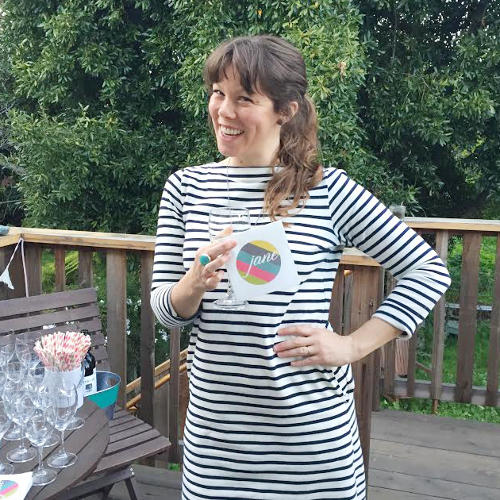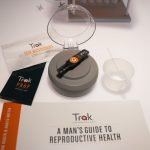The Quantified Vagina: This Startup Aims To Track Women’s Health Through Smart Tampons
Gretchen Anthony hadn’t been to an OB-GYN since her six-year-old child was born. “I didn’t have any medical issues, so I didn’t feel pressure to go,” she says. “I was busy. Life just got in the way.”
When she finally went for a physical, prompted by a concerned sister, she discovered she had high grade HPV—human papillomavirus—which had caused cancer cells to grow on her cervix. The surgeon tasked with giving her a hysterectomy said that it was the worst case of cervical cancer he had ever seen. And while his team was able to arrest the cancer before it spread, the operation permanently changed the hormonal balance of her body. She sweats profusely all the time and hasn’t been able to enjoy sex since.

Anthony realizes she should have been more judicious about keeping up with her annual health check-ups, but cervical cancer is asymptomatic and many women don’t catch it early enough. In fact, there are many dangerous conditions that women don’t realize they are living with: endometriosis, polycystic ovarian syndrome, uterine fibroids—the list goes on. Without treatment, these illnesses can destroy a woman’s fertility or be fatal.
Ridhi Tariyal and Stephen Gire, an entrepreneur and a scientist, respectively, who met in an infectious disease lab at Harvard, were stunned by the vast number of women’s health issues that go undetected. It seemed clear to them that there was a problem with the way that medical testing worked in women’s health. The system is fundamentally reactive, waiting for an illness to be detected before it springs into action. But when a positive test result comes back after an annual check-up, it could be too late.
“We had to come up with something that would allow women to find out about these conditions sooner than every year,” Tariyal says. “You can pick up a disease any time, and letting it sit there for a year until your next visit can have consequences downstream that you don’t want. The system has to change.”
Together, Tariyal and Gire have been devising a radical new system of testing that will allow women to proactively keep track of their health by studying blood samples in the privacy of their homes. “I was thinking about how to get a large enough volume of blood to do this,” Tariyal says. “Until I realized that we actually bleed quite a bit every month.”
That’s when the lightbulb came on in Tariyal’s head: A tampon could double as a tool for collecting women’s blood. With the right technology, it could even test the blood for a range of biomarkers and send that information to a database that would allow a woman to track her reproductive health over time. It could be the most intimate wearable technology yet and a milestone in the development of the quantified self.
In 2014, Tariyal and Gire launched a startup called NextGen Jane to begin work developing a “smart tampon” and gathering information about the kinds of data women want to learn about their bodies. They’ve been traveling around the country, gathering groups of women to discuss medical conditions they have had or are worried about, to learn how to better cater to their target consumers.
So far, they aren’t disclosing too many details about how their smart tampon will work—and anyway, before they can put a device like this on the market, they need to first develop a range of tests. Having just closed a round of seed funding led by Access Industries, they are currently conducting clinical trials to bring this testing to market.
“We have to get to a place where we have working, high-quality tests for enough conditions that it actually makes it worthwhile for women to test themselves every month,” says Tariyal, who is the company’s CEO. “Our vision is to manage reproductive health from menarche to menopause. We’re thinking about all the ways that women could find data about their bodies useful.”
Knowledge Imbalance
Doctors have the technology to track many aspects of women’s reproductive health, but women only tend to get access to information about their bodies when something goes wrong—if they have trouble getting pregnant, for instance, or start to feel pain. This is something that Tariyal discovered firsthand when she turned 33 and began thinking, in earnest, about having a baby.
The medical community regularly tells women that 35 is the magic age when their fertility drops off a cliff; if they are so lucky as to conceive, they are described as having a “geriatric pregnancy.” From her experience in the biotech industry, however, Tariyal knew there were ways to give women more specific data about their own fertility, since ethnicity, genetics, and a range of other factors can play into a woman’s fertility. It is possible to track a hormone called Anti-Mullerian as a proxy for how many eggs a woman has left, otherwise known as her “ovarian reserve.” By comparing your personal hormone reading to the rest of the population, you are able to get a sense of whether your fertility is declining faster or slower than average.
However, some doctors are unwilling to give women access to this information unless you have tried and failed to conceive. It’s not exactly clear why; Tariyal suspects that they didn’t want her to worry unnecessarily or misinterpret the test results.
“There’s a sense in which these tests are paternalistic,” Tariyal says. “Women don’t like it when someone tells them when to worry or when not to worry. I wanted that number regardless of whether I was in a relationship or trying to get pregnant. That number belongs to me.”
That’s one reason why Tariyal believes that women who want to keep tabs on their ovarian reserve should have the option to do so. NextGen Jane’s smart tampon technology, for instance, could allow women to track their anti-mullerium hormone levels so that when they faced difficult choices about whether to start a family or focus on their career, they would have that figure handy. This would allow them to have access to several data points when they are thinking about family planning.
This kind of fertility-detecting technology was perhaps less necessary in the past, when more women had children in their late teens and early twenties.
“Our framework is that your reproductive health now is something you need to manage proactively,” Tariyal says. “The time between getting your period and having children is much longer than before, which gives you many more opportunities for something to go wrong with your reproductive system.”

Early Interventions
Many diseases that lead to problems with infertility go often unnoticed. Chlamydia and gonorrhea, for instance, don’t have obvious symptoms in women, so 80% of the time female carriers don’t realize they have it. However, if the bacteria that causes those illnessses ascends a woman’s reproductive tract, they can cause pelvic inflammatory disease, which can cause infertility. If detected early—say, potentially, by a smart tampon—both of these STDs can be easily cleared up with antibiotics.
Endometriosis, a disorder in which the tissue lining of the uterus grows outside the uterus, is one of the top reasons that women eventually end up at IVF clinics. Most women realize they have the illness when they are in their 30s, but it actually begins far earlier. “Most women have had it for quite a while and just didn’t know it,” she says.
Take Mandy Hixson Hanna, a designer who lives in the Bay Area. Ever since her teenage years, she had experienced heavy, irregular, and excruciatingly painful periods that required her to take heavy-duty painkillers. However, since other women talked about period discomfort, Hanna assumed that her periods were normal. They weren’t. It wasn’t until she was trying to conceive that she discovered that something was wrong. After several ultrasounds, doctors suspected that she might have fibroids. It wasn’t until she had surgery to remove two growths the size of tennis balls on her uterus that it became clear that she had had endometriosis all along. In fact, the estrogen-based birth control she had been taking throughout her life had actually accelerated the spread of the tissue.
“If I had been taking measures to keep it under control when I was in my teens, I could have spared myself all of this pain and the possibility of becoming infertile,” Hanna says. “Endometriosis would have just been a chronic condition, and I could have taken progesterone to keep the cysts and growths at bay.”
NextGen Jane is trying to develop a test for a biomarker in menstrual blood that might identify whether or not a woman has endometriosis. The company is currently in the midst of clinical trials for this condition, among many others that the smart tampon will ultimately test for.
It is still early days for the company, but it already has a working prototype and will have a final product in the next year or so.
“We believe that women have the capacity to understand these tests,” Tariyal says. “Women who are data-forward want to be empowered to track their own health at a granular level.”
Next Gen Jane is devising a system of testing that will allow women to keep track of their health by studying blood samples in their homes.

Founders Ridhi Tariyal and Stephen Gire are developing a “smart tampon” that will test women’s menstrual blood every month.

The tampon will then send that information to a database that would allow a woman to track her reproductive health over time.

Next Gen Jane commissioned this image, and the three previous ones, by artists who believe in the company’s mission.

The founders have been gathering groups of women to discuss conditions they have or are worried about, to learn how to cater to target consumers.

They were stunned by the vast number of women’s health issues that go undetected.

It seemed clear to them that there was a problem with medical testing in women’s health: The system is fundamentally reactive.

But when a positive test result comes back after an annual check-up, it could be too late.

Click on to see pictures of the Next Gen Jane team at work.

Fast Company , Read Full Story
(59)













